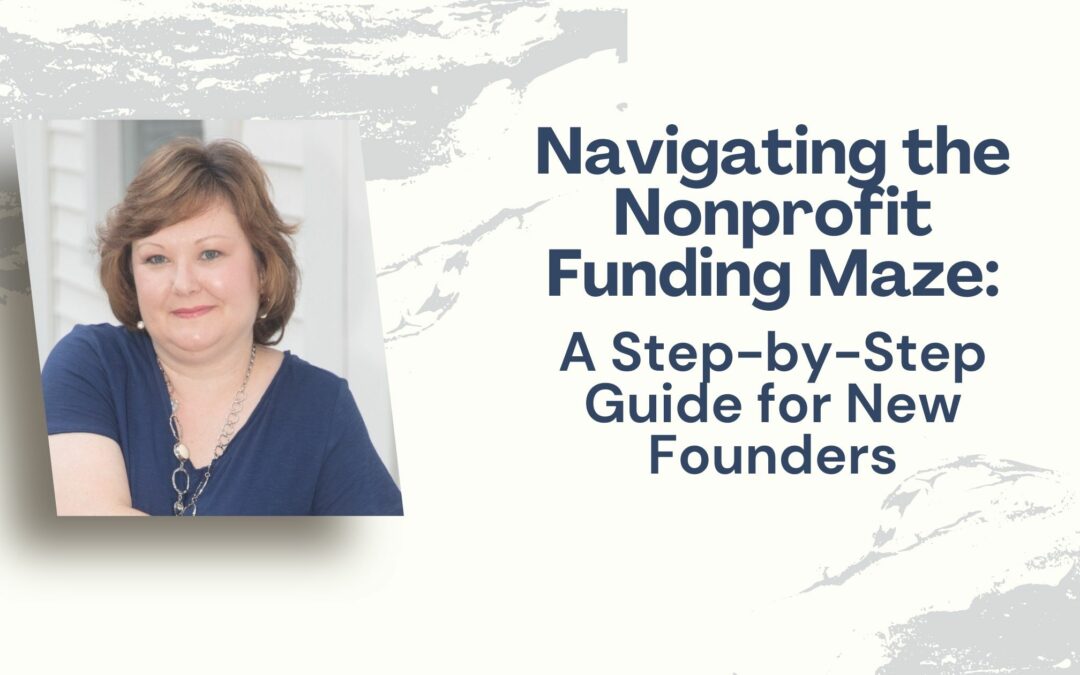Navigating the Nonprofit Funding Maze: A Step-by-Step Guide for New Founders
Starting a nonprofit is an exciting journey filled with passion, purpose, and a deep desire to make a difference. But let’s face it: securing funding as a new nonprofit founder can feel like navigating a complex maze. With so many options, obstacles, and potential dead ends, it’s easy to feel overwhelmed. But don’t worry—I’ve been there too and am here to help guide you through the process.
In this post, I’ll share a step-by-step guide to help you navigate the nonprofit funding landscape. These steps are based on insights from my book, I Need Funding! Now What?!? A Guide for Nonprofit Founders, where I dive even deeper into the strategies that can help you secure the funding your nonprofit needs to thrive.
Step 1: Understanding the Nonprofit Landscape
Before you dive into fundraising, it’s crucial to have a solid understanding of the broader nonprofit sector. The nonprofit world is diverse, with various types of organizations, each serving different missions. Understanding where your organization fits within this landscape is key to identifying the right funding opportunities.
Nonprofits can take many forms, from 501(c)(3) organizations focused on charitable work to 501(c)(4) groups engaged in advocacy. Knowing the differences can help you navigate the legal and financial aspects of fundraising.
But it’s not just about the legal structure. Nonprofits play a vital role in society, addressing needs and issues that might otherwise go unmet. From providing essential services to driving social change, nonprofits are at the forefront of creating a positive impact. However, even the most well-intentioned organizations can struggle to achieve their goals without sufficient funding.
Tips for Success:
- Research the different types of nonprofits and determine which category your organization falls into.
- Understand your nonprofit’s role in society and how this influences your funding strategy.
Step 2: Identifying Your Funding Needs
Once you’ve got a handle on the nonprofit landscape, it’s time to identify your organization’s specific funding needs. This step is about clarity—knowing exactly what you need, how much you need, and why.
Start by assessing your organization’s financial requirements. This involves breaking down your budget to understand both your income and expenses. It’s essential to differentiate between short-term and long-term funding needs. Short-term needs might include operating expenses like rent and salaries, while long-term needs could involve growth or capacity-building investments.
Conducting a gap analysis can help you identify the difference between your projected income and expenses, giving you a clear picture of the funding gap you need to fill. And don’t forget to plan for an emergency fund—a financial cushion that can keep your organization afloat in case of unexpected challenges.
Tips for Success:
- Create a detailed budget that outlines all income sources and expenses.
- Conduct a gap analysis to determine the exact amount of funding needed.
- Set aside a portion of your budget for an emergency fund to ensure financial stability.
Step 3: Building a Strong Foundation
A solid foundation is essential for any successful fundraising effort. This means having a clear mission, vision, compelling story, and strong organizational structure.
Your mission statement is your North Star—it guides everything you do. It should clearly define the problem your nonprofit is solving, who you’re serving, and how you’re making a difference. Your vision statement, on the other hand, should paint a picture of the future you’re striving to create.
In addition to your mission and vision, your nonprofit’s story is a powerful tool for connecting with donors. People give to people, not just causes, so make sure your story is authentic, emotional, and relatable.
Finally, a strong organizational structure, including a diverse and committed board of directors, is crucial for building credibility with potential funders. Your board should bring a mix of skills, experiences, and perspectives that align with your mission.
Tips for Success:
- Craft a clear and compelling mission and vision statement.
- Develop an authentic nonprofit story that resonates with your audience.
- Build a strong organizational structure with a committed board of directors.
Step 4: Exploring Funding Sources
With your foundation in place, it’s time to explore the various funding sources available to nonprofits. The good news is, there are many options to choose from—each with its own set of advantages and challenges.
Individual Donors are often the lifeblood of nonprofit funding. These are people who believe in your mission and are willing to support it financially. Building relationships with individual donors is about more than just asking for money—it’s about engaging them in your cause and showing them the impact of their contributions.
Crowdfunding is another powerful tool, especially in today’s digital age. Platforms like GoFundMe and Kickstarter allow you to reach a broad audience and rally support for specific projects or initiatives.
Corporate Sponsorships offer the opportunity to partner with businesses that share your values. These partnerships can provide financial support as well as valuable exposure for your nonprofit.
Grants from foundations and government agencies can also be a significant source of funding. While the application process can be competitive, securing a grant can provide the financial boost your nonprofit needs to achieve its goals.
Tips for Success:
- Diversify your funding streams by exploring multiple sources of income.
- Build strong relationships with individual donors through regular communication and engagement.
- Consider crowdfunding for specific projects or initiatives to reach a broader audience.
Step 5: Crafting Effective Fundraising Strategies
The final step in navigating the nonprofit funding maze is to craft a well-thought-out fundraising strategy. This involves setting SMART (Specific, Measurable, Achievable, Relevant, Time-bound) goals, choosing the right fundraising methods, and executing your plan with precision.
Your fundraising strategy should include a mix of online and offline methods. In today’s world, digital fundraising is a must, whether through email campaigns, social media, or crowdfunding. However, traditional methods like direct mail and in-person events still have their place, especially when building deeper relationships with donors.
Donor stewardship is also a critical component of any fundraising strategy. This means taking care of your donors by keeping them informed, thanking them for their support, and showing them the impact of their contributions. A well-stewarded donor is more likely to become a long-term supporter.
Tips for Success:
- Set SMART goals to guide your fundraising efforts.
- Combine online and offline fundraising methods for a well-rounded approach.
- Prioritize donor stewardship to build lasting relationships and secure ongoing support.
Conclusion
Navigating the nonprofit funding maze may seem daunting, but with the right steps, you can successfully secure your organization’s funding to thrive. By understanding the nonprofit landscape, identifying your funding needs, building a strong foundation, exploring diverse funding sources, and crafting effective fundraising strategies, you’ll be well on your way to achieving your mission.
If you’re ready to dive deeper into these strategies and learn more about how to secure funding for your nonprofit, I encourage you to check out my book I Need Funding! Now What?!? A Guide for Nonprofit Founders. It’s packed with practical advice, real-world examples, and actionable steps to help you navigate the complex world of nonprofit funding. You can purchase the book here on Amazon. If you’ve purchased the book, don’t forget to download your templates here.
Remember, you don’t have to navigate this journey alone. Let’s tackle the challenges together and secure the funding your nonprofit deserves!


Recent Comments